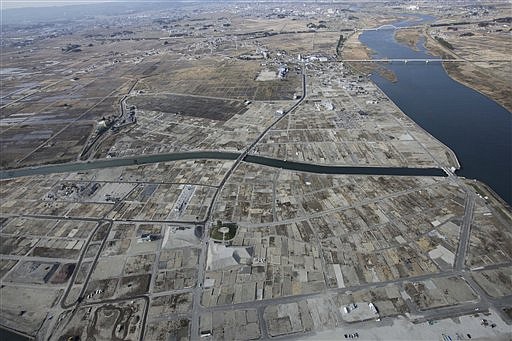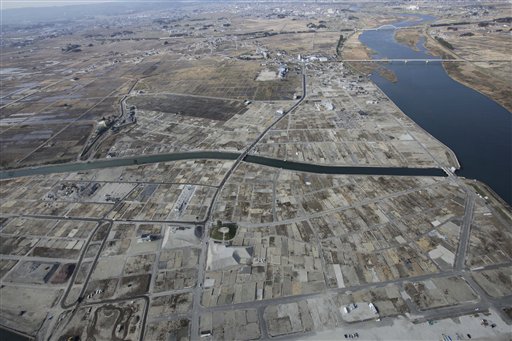SENDAI, Japan - From 1,000 feet (300 meters) up, the view of the tsunami-battered Japanese seaside communities shows striking progress: much of the rubble, crumpled cars and other debris is gone.
Yet seen from a helicopter Friday carrying Associated Press journalists, there are few signs of rebuilding eight months after the March 11 disaster, triggered by a magnitude-9.0 earthquake off the tsunami-prone coast.
What remains - the stark, gray emptiness where bustling towns once stood - is a sobering reminder of how much work still lies ahead.
On the ground, people living in the tidy rows of temporary houses that dot the surrounding areas say they are frustrated that authorities aren't moving ahead more quickly with reconstruction plans. They are anxious to rebuild their lives, yet remain uncertain of how to proceed.
"I want to leave this place as soon as possible and move into our own house, but the feeling I'm getting from the banks and government is that's going to be hard," said Yuki Numakura, 36, from Natori, near Sendai, who shares a unit with her mother, brother, grandmother and pet dog Seven.
"The future looks really murky," she said.
Prime Minister Yoshihiko Noda's government plans to spend at least 18 trillion yen ($234 billion) over the next five years to fund the reconstruction, 6 trillion yen of which has been approved by parliament. So far, the government has built 51,886 temporary houses - almost all of the 52,500 needed - in seven prefectures (states) affected by the disaster.
Ultimately, decisions about reconstruction of each town fall to local town leaders, but uncertainty about the extent and speed of aid from the central government has caused some towns to move cautiously.
The towns have just begun to come out with longer-term reconstruction plans, which include input from residents and seek ways to better protect their communities from future tsunamis. Many are also reluctant to rebuild in low-lying areas for fear that another massive wave may strike again sooner or later, given that four have hit the coastline in the last 120 years.
The fishing town of Minamisanriku, which lost 70 percent of its buildings in the disaster, calls for building residential areas on higher ground, even cutting into the surrounding hills, and possibly raising the town's commercial district slightly from the fishing docks, a key hub of activity. To help people better escape from future tsunamis, the town plans to widen evacuation routes and increase the number of elevated shelters.
Minamisanriku's reconstruction plan extends 10 years into the future. Facing a shrinking and aging population, it seeks to revive its local economy through promoting tourism and drawing new business.
The biggest challenge facing town leaders at this point is balancing residents' demands to restore homes and jobs quickly while coming up with a viable long-term plan, said Tsuneaki Fukui, a civil engineering professor at the University of Tokyo who is helping the major fishing port of Kesennuma, further up the coast, draw up its reconstruction plans.
"The scale of this - the entire coastline - makes it all so overwhelming," he said. "It's something even we professionals haven't ever encountered."
The disaster left 15,839 dead and 3,647 missing, according to the official toll. The high number of missing is because the dead are only counted when a body is identified.
Further south, the tsunami also touched off a nuclear crisis when it slammed into the Fukushima Dai-ichi power plant, forcing about 100,000 people to flee their homes. They still have no idea when they can return.
Disposing of all the debris - an estimated 23 million tons - is another huge headache. While most has been removed from town centers, completely disposing of it will likely take another 2 1/2 years, the government estimates.
A large amount of debris has wound up in Natori, a flat area near the Sendai airport, where it has been carefully divided into huge mountains of wood, metal, hazardous waste and other materials. On Friday, dozens of cranes and backhoes picked away at the stuff, dumping it into waiting trucks to be hauled off.
Some of it is recycled. Concrete, for example, is sent to cement factories for reprocessing into small pebbles for use in road construction, the Environment Ministry says. The rest is to be incinerated and used as landfill - although incinerators in the prefecture are overwhelmed by the volume and have asked for help from elsewhere.
Just a few miles (kilometers) away from the whirring construction vehicles, 75-year-old Yaeko Sai, who lost her Natori home in the tsunami, thinks anxiously about the future in the shadow of her temporary housing block.
"My friends have scattered everywhere," she said. "I'm really not sure how I could make it if I had to leave this place."
---
Associated Press writer Mari Yamaguchi in Tokyo contributed to this report.

